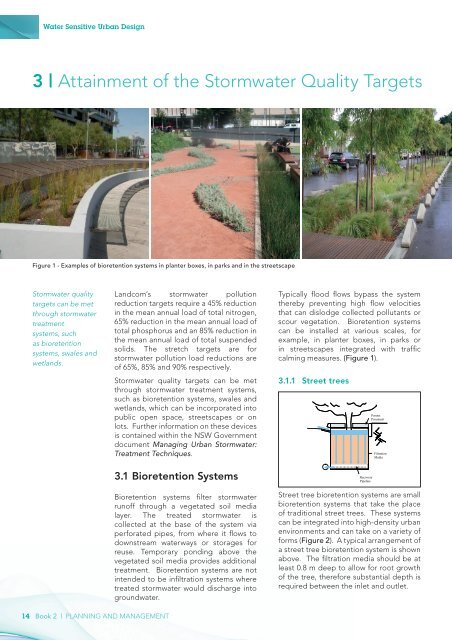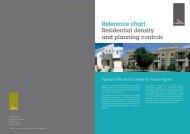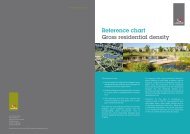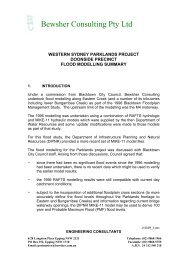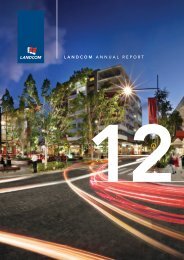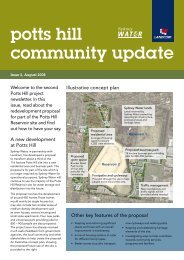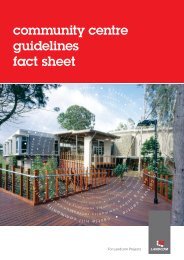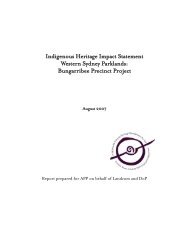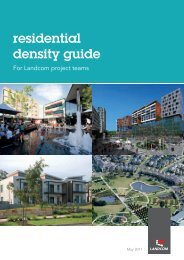Water Sensitive Urban Design
Book 2 | Planning and Management - WSUD
Book 2 | Planning and Management - WSUD
- No tags were found...
You also want an ePaper? Increase the reach of your titles
YUMPU automatically turns print PDFs into web optimized ePapers that Google loves.
<strong>Water</strong> <strong>Sensitive</strong> <strong>Urban</strong> <strong>Design</strong><br />
3 | Attainment of the Stormwater Quality Targets<br />
Figure 1 - Examples of bioretention systems in planter boxes, in parks and in the streetscape<br />
Stormwater quality<br />
targets can be met<br />
through stormwater<br />
treatment<br />
systems, such<br />
as bioretention<br />
systems, swales and<br />
wetlands.<br />
Landcom’s stormwater pollution<br />
reduction targets require a 45% reduction<br />
in the mean annual load of total nitrogen,<br />
65% reduction in the mean annual load of<br />
total phosphorus and an 85% reduction in<br />
the mean annual load of total suspended<br />
solids. The stretch targets are for<br />
stormwater pollution load reductions are<br />
of 65%, 85% and 90% respectively.<br />
Stormwater quality targets can be met<br />
through stormwater treatment systems,<br />
such as bioretention systems, swales and<br />
wetlands, which can be incorporated into<br />
public open space, streetscapes or on<br />
lots. Further information on these devices<br />
is contained within the NSW Government<br />
document Managing <strong>Urban</strong> Stormwater:<br />
Treatment Techniques.<br />
3.1 Bioretention Systems<br />
Bioretention systems filter stormwater<br />
runoff through a vegetated soil media<br />
layer. The treated stormwater is<br />
collected at the base of the system via<br />
perforated pipes, from where it flows to<br />
downstream waterways or storages for<br />
reuse. Temporary ponding above the<br />
vegetated soil media provides additional<br />
treatment. Bioretention systems are not<br />
intended to be infiltration systems where<br />
treated stormwater would discharge into<br />
groundwater.<br />
Typically flood flows bypass the system<br />
thereby preventing high flow velocities<br />
that can dislodge collected pollutants or<br />
scour vegetation. Bioretention systems<br />
can be installed at various scales, for<br />
example, in planter boxes, in parks or<br />
in streetscapes integrated with traffic<br />
calming measures. (Figure 1).<br />
3.1.1 Street trees<br />
Recovery<br />
Pipeline<br />
Porous<br />
Pavement<br />
Filtration<br />
Media<br />
Street tree bioretention systems are small<br />
bioretention systems that take the place<br />
of traditional street trees. These systems<br />
can be integrated into high-density urban<br />
environments and can take on a variety of<br />
forms (Figure 2). A typical arrangement of<br />
a street tree bioretention system is shown<br />
above. The filtration media should be at<br />
least 0.8 m deep to allow for root growth<br />
of the tree, therefore substantial depth is<br />
required between the inlet and outlet.<br />
14 Book 2 | planning and management


